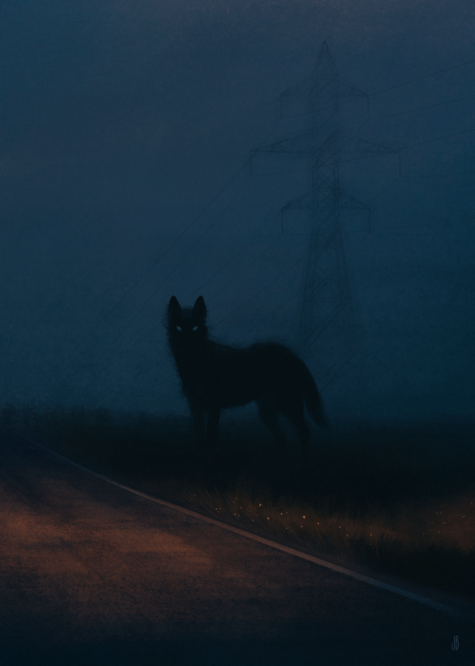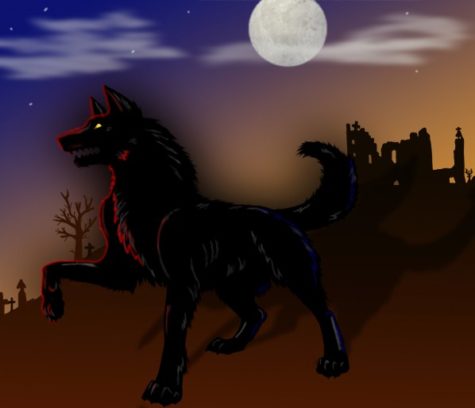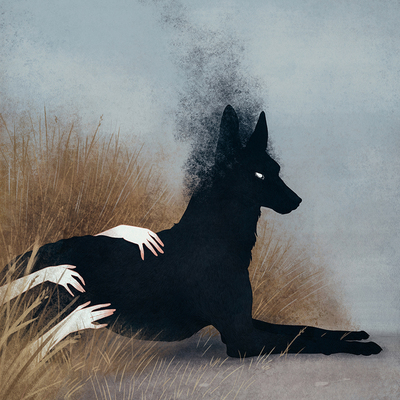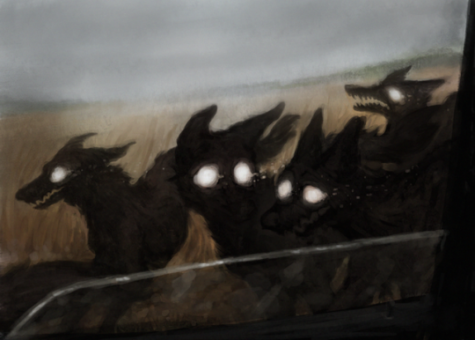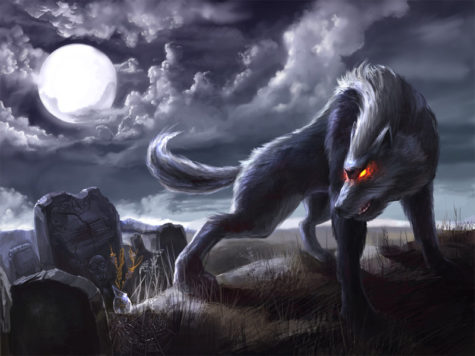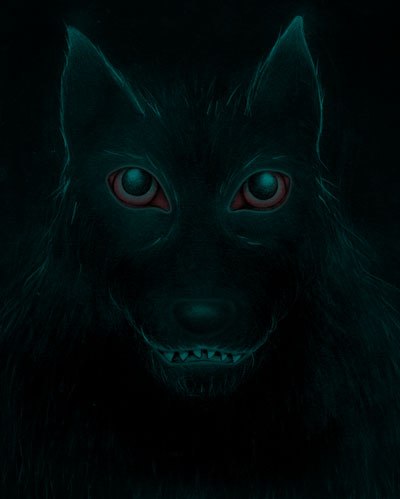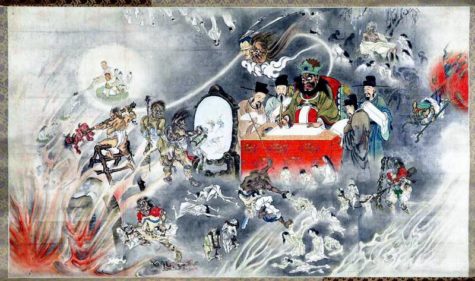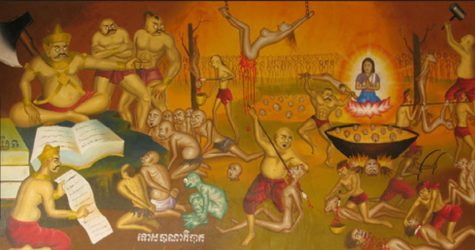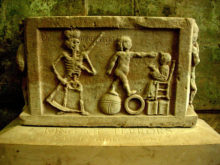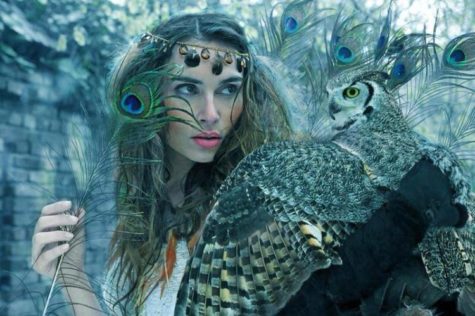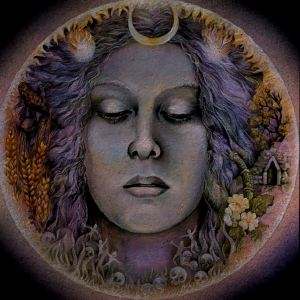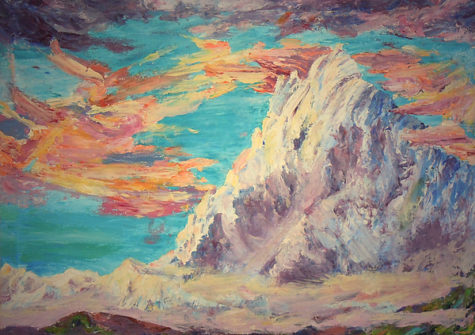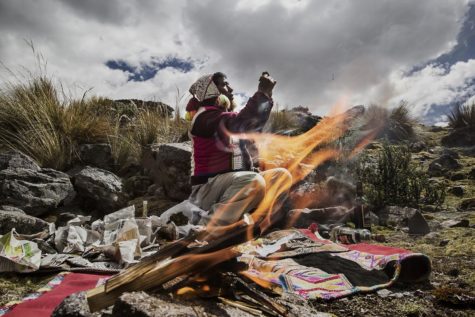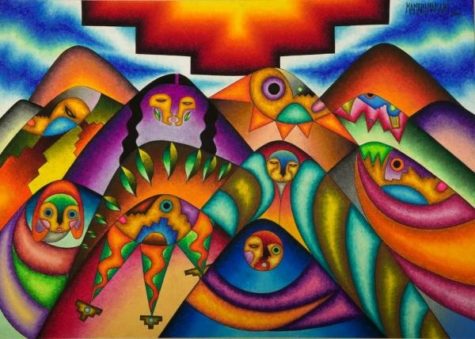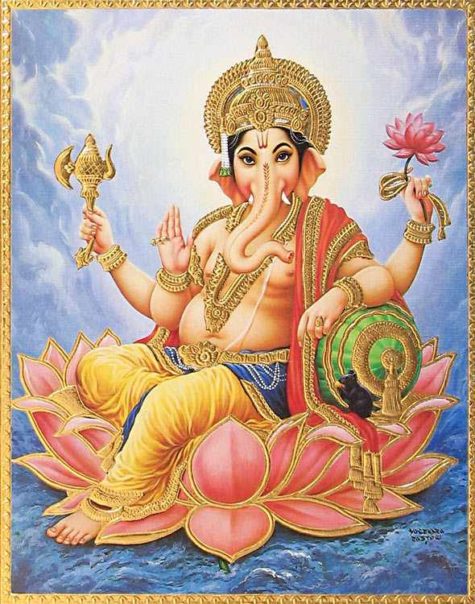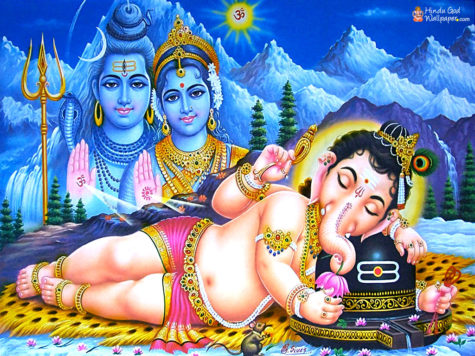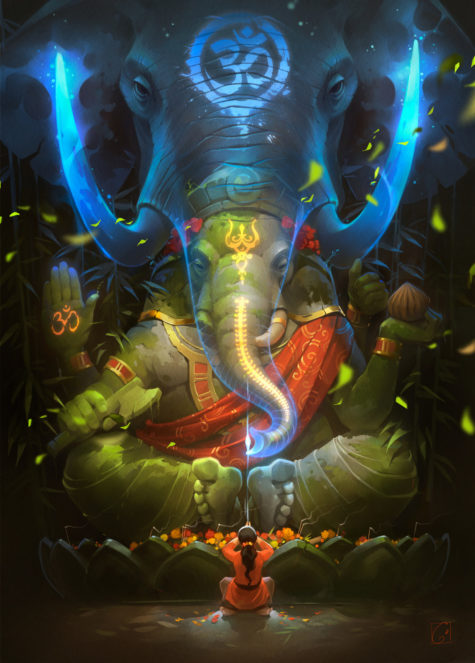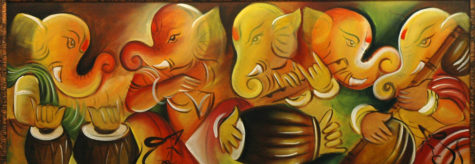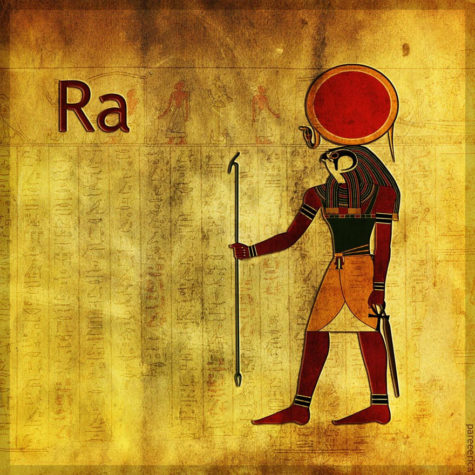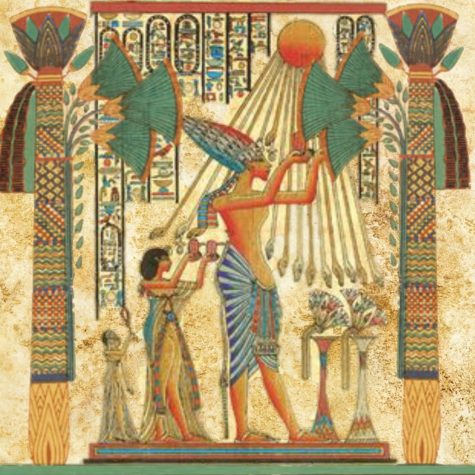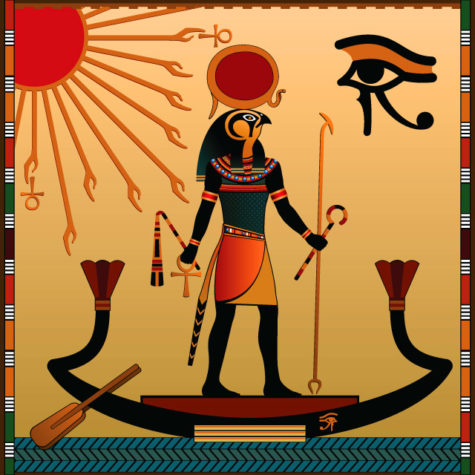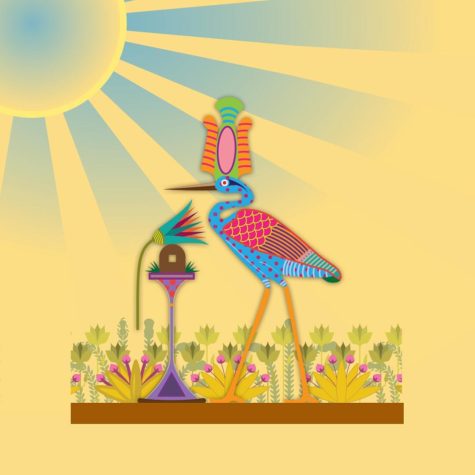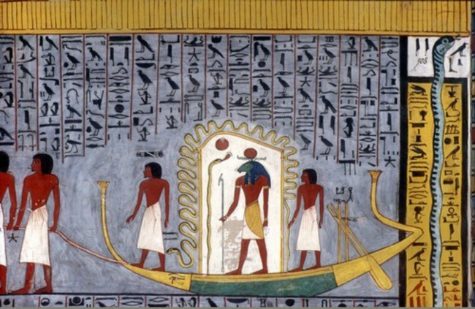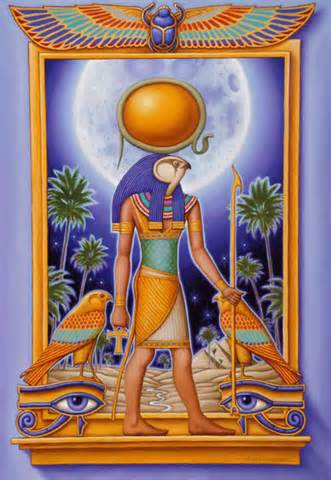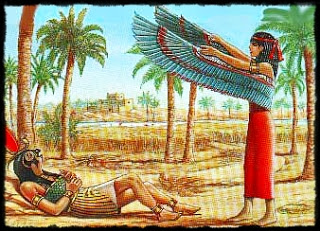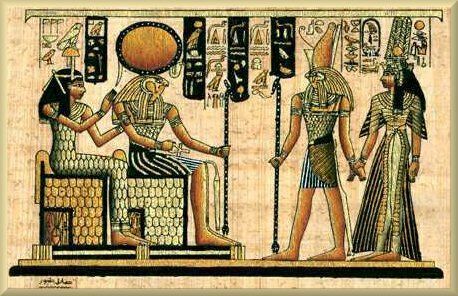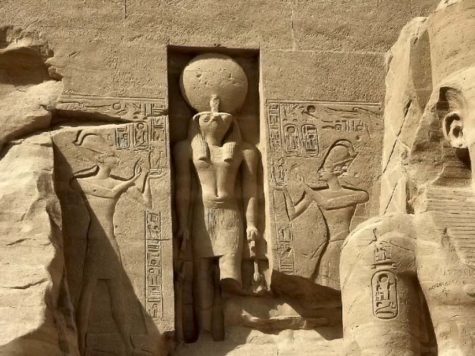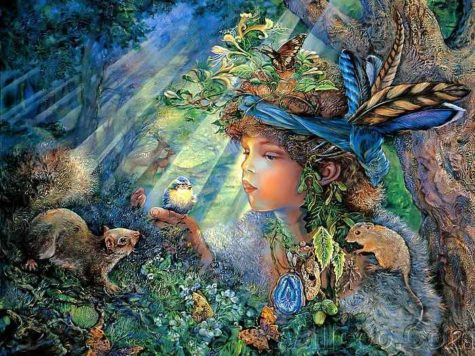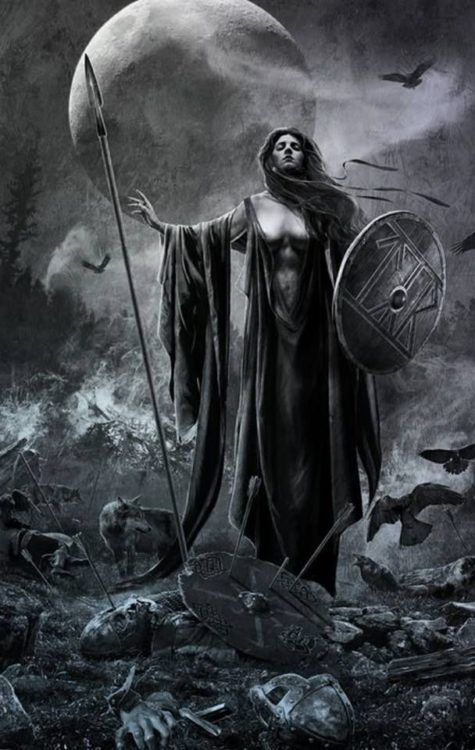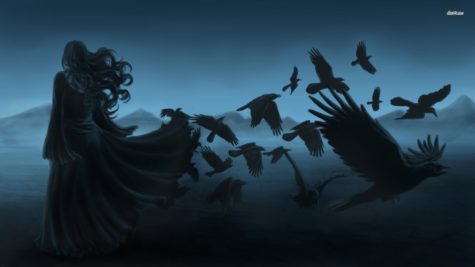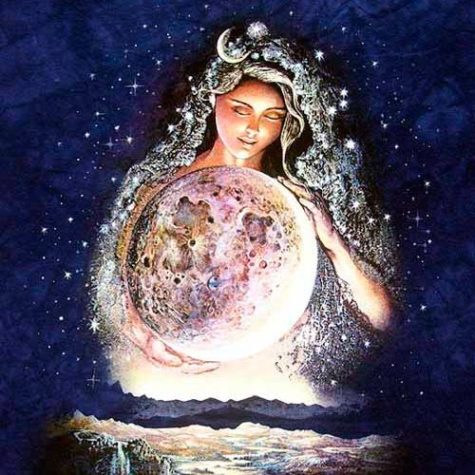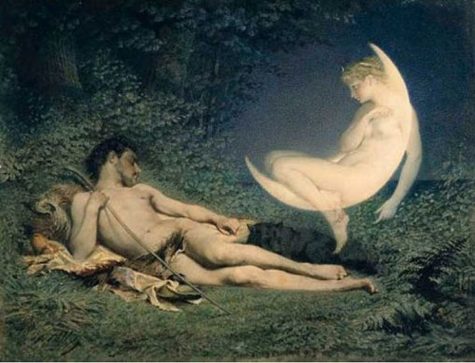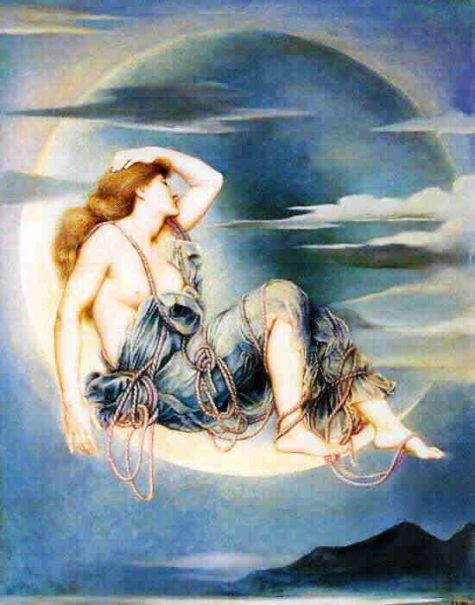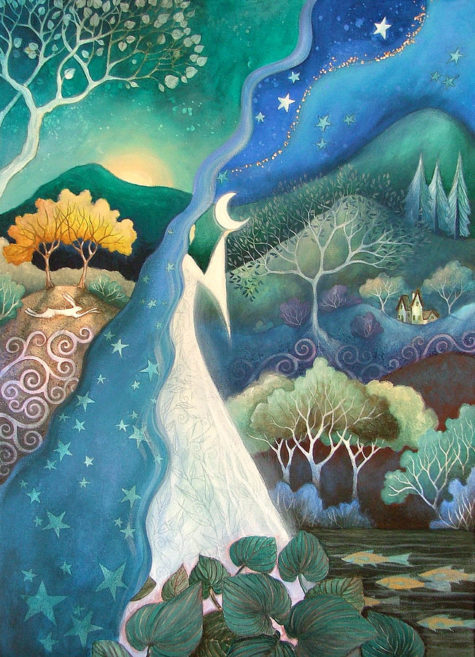The Black Dog is among Britain’s most famous spectral hounds. It may be dangerous and malevolent or helpful and benevolent. It usually serves as a guardian of treasure or a sacred place. If left alone, it usually leaves you alone, too, but if aggression is shown toward it, the Black Dog isn’t afraid to demonstrate supernatural powers, potentially causing terrible wounds, paralysis, or death before vanishing into thin air.
- Manifestation: A shaggy black dog the size of a calf with glowing, red eyes.
- Other names: Moddey Dhoo, Mauthe Doog, Black Shuck, Old Shuck, Old Shock
This ghostly canine is also known as Mauthe Doog, a calf sized black dog who haunts Peel Castle on the Isle of Man. Guards saw the specter so often, they eventually grew less fearful. But, according to lore, one drunk soldier went down a passage in the castle to confront the ghost dog. He came back too terrified to speak and died three days later. The passage was sealed and never used again. Mauthe Doog sightings, however, continued.
Black Shuck
Black Shuck, Old Shuck, Old Shock or simply Shuck is the name given to a ghostly black dog which is said to roam the coastline and countryside of East Anglia, one of many ghostly black dogs recorded in folklore across the British Isles. Accounts of Black Shuck form part of the folklore of Norfolk, Suffolk, the Cambridgeshire fens and Essex, and descriptions of the creature’s appearance and nature vary considerably; it is sometimes recorded as an omen of death, but, in other instances, is described as companionable.
According to the Oxford English Dictionary, the name Shuck derives from the Old English word scucca – “devil, fiend”, from the root word skuh- to terrify. The first mention in print of “Black Shuck” is by Reverend E.S. Taylor in an 1850 edition of the journal Notes and Queries which describes “Shuck the Dog-fiend”;
“This phantom I have heard many persons in East Norfolk, and even Cambridgeshire, describe as having seen as a black shaggy dog, with fiery eyes and of immense size, and who visits churchyards at midnight.”
Images of black sinister dogs have become part of the iconography of the area and have appeared in popular culture. Writing in 1877, Walter Rye stated that Shuck was “the most curious of our local apparitions, as they are no doubt varieties of the same animal.”
Descriptions of Black Shuck vary in both shape and size, from that of a large dog to being the size of a calf or horse. W. A. Dutt, in his 1901 Highways & Byways in East Anglia describes the creature thus:
He takes the form of a huge black dog, and prowls along dark lanes and lonesome field footpaths, where, although his howling makes the hearer’s blood run cold, his footfalls make no sound. You may know him at once, should you see him, by his fiery eye; he has but one, and that, like the Cyclops’, is in the middle of his head. But such an encounter might bring you the worst of luck: it is even said that to meet him is to be warned that your death will occur before the end of the year.
So you will do well to shut your eyes if you hear him howling; shut them even if you are uncertain whether it is the dog fiend or the voice of the wind you hear. Should you never set eyes on our Norfolk Snarleyow you may perhaps doubt his existence, and, like other learned folks, tell us that his story is nothing but the old Scandinavian myth of the black hound of Odin, brought to us by the Vikings who long ago settled down on the Norfolk coast.
Dr Simon Sherwood suggests that the earliest surviving description of devilish black hounds is an account of an incident in the Peterborough Abbey recorded in the Peterborough Chronicle (one version of the Anglo-Saxon Chronicle) around 1127.
This account also appears to describe the Europe-wide phenomenon of a Wild Hunt.:
Let no-one be surprised at the truth of what we are about to relate, for it was common knowledge throughout the whole country that immediately after [Abbot Henry of Poitou’s arrival at Peterborough Abbey] – it was the Sunday when they sing Exurge Quare – many men both saw and heard a great number of huntsmen hunting.
The huntsmen were black, huge and hideous, and rode on black horses and on black he-goats and the hounds were jet black with eyes like saucers and horrible. This was seen in the very deer park of the town of Peterborough and in all the woods that stretch from that same town to Stamford, and in the night the monks heard them sounding and winding their horns.
Reliable witnesses who kept watch in the night declared that there might well have been as many as twenty or thirty of them winding their horns as near they could tell. This was seen and heard from the time of his arrival all through Lent and right up to Easter.”
Abraham Fleming’s account of the appearance of “A strange, and terrible wunder” in 1577 at Bungay, Suffolk is a famous account of the beast.
“A straunge, and terrible Wunder wrought very late in the parish church of Bongay: a town of no great distance from the citie of Norwich, namely the fourth of this August, in the yeere of our Lord 1577. in a great tempest of violent raine, lightning, and thunder, the like wherof hath been seldome seene. With the appeerance of an horrible shaped thing, sensibly perceiued of the people then and there assembled. Drawen into a plain method according to the written copye. by Abraham Fleming.”
One of the most notable reports of Black Shuck is of his appearance at the churches of Bungay and Blythburgh in Suffolk. On 4 August 1577, at Blythburgh, Black Shuck is said to have burst in through the doors of Holy Trinity Church to a clap of thunder. He ran up the nave, past a large congregation, killing a man and boy and causing the church steeple to collapse through the roof. As the dog left, he left scorch marks on the north door which can be seen at the church to this day.
The encounter on the same day at St Mary’s Church, Bungay was described in A Straunge and Terrible Wunder by Abraham Fleming in 1577:
This black dog, or the divel in such a linenesse (God hee knoweth al who worketh all,) running all along down the body of the church with great swiftnesse, and incredible haste, among the people, in a visible fourm and shape, passed between two persons, as they were kneeling uppon their knees, and occupied in prayer as it seemed, wrung the necks of them bothe at one instant clene backward, in somuch that even at a mome[n]t where they kneeled, they stra[n]gely dyed.
Fleming was a translator and editor for several printing houses in London, and therefore probably only published his account based on exaggerated oral accounts. Other local accounts attribute the event to the Devil (Fleming calls the animal “the Divel in such a likeness”). The scorch marks on the door are referred to by the locals as “the devil’s fingerprints”, and the event is remembered in this verse:
All down the church in midst of fire, the hellish monster flew, and, passing onward to the quire, he many people slew.
Dr David Waldron and Christopher Reeve suggest that a fierce electrical storm recorded by contemporary accounts on that date, coupled with the trauma of the ongoing Reformation, may have led to the accounts entering folklore.
Littleport, Cambridgeshire is home to two different legends of spectral black dogs, which have been linked to the Black Shuck folklore, but differ in significant aspects: local folklorist W.H. Barrett relates the story of a huge black dog haunting the area after being killed rescuing a local girl from a lustful friar in pre-reformation times, while fellow folklorist Enid Porter relates stories of a black dog haunting the A10 road after its owner drowned in the nearby River Great Ouse in the 1800s.
Sources:
Also known as The Ten Kings, or the Ten Judges of Hell; the Ten Kings of Hell are afterlife judges. They derive from Chinese Taoist tradition, filtered through Japanese Buddhism.
- Those who have clearly lived exemplary lives travel to Paradise.
- Those who have been clearly wicked travel to a punishment realm.
But what of those whose actions are more ambiguous? Those who may have performed both good and bad deeds while alive? Where do they go? That’s for the Kings of Hell to decide.
The Kings of Hell preside over a series of afterlife trials intended to determine the fate of the dead soul. The person’s actions while alive, both positive and negative are weighed, analyzed and discussed. Jizo serves as the defense attorney for dead souls and always attempts to present human actions in the best possible light. Final outcome, however is up to the Kings of Hell.
The Eighteen Levels of Hell
Chinese legends speak of the “Eighteen Levels of Hell”. Each court deals with a different aspect of atonement and different punishments; most legends claim that sinners are subjected to gruesome tortures until their “deaths”, after which they are restored to their original state for the torture to be repeated.
The concept of the eighteen hells started in the Tang dynasty. The Buddhist text Wen Diyu Jing mentioned 134 worlds of hell, but was simplified to the Eighteen Levels of Hell for convenience. Sinners feel pain and agony just like living humans when they are subjected to the tortures listed below. They cannot “die” from the torture because when the ordeal is over, their bodies will be restored to their original states for the torture to be repeated. The following is a list of common punishments and tortures in the hells:
- Mountain of Knives: Sinners are thrown off cliffs and land on mountainous terrain with sharp blades sticking out. Some depictions show offenders climbing trees with knives or sharp thorns sticking out of trunks and branches.
- Cauldron torture: Sinners are fried in cauldrons of oil.
- Dismemberment: Sinners are dismembered by various means, including sawing, slicing into half, mashing/pounding into pulp, being crushed by rocks/boulders, being run over by vehicles, etc.
- Grinding torture: Sinners are put into a grinding machine and ground into a bloody pulp.
- Burning: Sinners are set aflame or cast into infernos.
- Paolao torture: Sinners are stripped naked and tied to a large hollow metal cylinder with a fire lit at its base.
- Boiling liquid torture: Boiling liquids are forced down sinners’ throats or poured on parts of their bodies.
- Tortures involving removal of body parts or organs: Tongue ripping, eye gouging, teeth extraction, heart digging, disembowelment, skinning, etc.
- Ice World: Sinners are frozen in ice. Some depictions show unclothed sinners suffering frostbite in an icy world. Their bodies eventually fall apart or break into pieces.
- Scales and hooks torture: Sinners are pierced with hooks and hung upside-down. Some depictions show sinners having nails hammered into their bodies.
- Pool of Blood: Sinners are cast into a pool of filthy blood, where they drown. Blood spills from all bodily orifices.
- Tortures involving animals: Sinners are trampled by cattle, gored by animals with horns or tusks, mauled or eaten by predators, stung or bitten by poisonous species, etc.
- Avīci: The period of suffering in this chamber is the longest. It is reserved for sinners who have committed heinous crimes, including the Five Grave Offences.
Some literature refers to eighteen types of hells or to eighteen hells for each type of punishment. Some religious or literature books say that wrongdoers who were not punished when they were alive are punished in the hells after death.
The Five Grave Offences:
Ānantarika-karma or ānantarika-kamma is a heinous crime that through karmic process brings immediate disaster. They are called ‘anantarika’ because they are ‘an’ (without) ‘antara’ (interval), in other words the results immediately come to fruition in the next life, i.e. the participant goes straight to hell.
These are considered so heinous that Buddhists and non-Buddhists must avoid them. According to Buddhism, committing such a crime would prevent the perpetrator from attaining the stages of sotāpanna, sakadagami, anāgāmi or arhat in that lifetime. The five crimes are:
- Intentionally murdering one’s father.
- Intentionally murdering one’s mother.
- Killing an Arhat (fully enlightened being).
- Shedding the blood of a Buddha.
- Creating a schism within the Sangha, the community of Buddhist monks, nuns and pariṣā who try to attain enlightenment.
In Mahayana Buddhism these five crimes are referred to as pañcānantarya and are mentioned in “The Sutra Preached by the Buddha on the Total Extinction of the Dharma”.
Source: Wikipedia
The King of Terrors is among those spirits classified as Holy Death. He is closely related to the Grim Reaper. The King of Terrors is a skeleton bearing weapons. He may be crowned. He is a psychopomp but a fierce, scary one. His name says it all. He does not arrive bearing comfort or platitudes.
The name, King of Terrors, derives from the Book of Job 18:14:
“He is torn from the security of his tent
and marched before the King of Terrors.
Thus the King of Terrors is traditionally depicted driving dead souls before him. His image is carved onto tombstones and as ornamental motifs on medieval churches, most famously at Scotland’s Rosslyn Chapel.
Source: The Encyclopedia of Spirits
Great Goddess, Moon Goddess, Queen of the Witches
In the late twentieth century, Aradia emerged as an important Wiccan goddess. She is a major spiritual inspiration for modern Wiccans and practitioners of witchcraft. Rites and descriptions are found within her book and testament. Here’s a link to her story and teachings: The Story of Aradia.
- Number: 13
- Offerings: Strega liquore, walnuts, rue, tools of witchcraft and divination
Aradia has become an important figure in Wicca as well as some other forms of Neo-Paganism. Some Wiccan traditions use the name “Aradia” as one of the names of the Great Goddess, Moon Goddess or “Queen of the Witches”. Portions of Leland’s text influenced the Gardnerian Book of Shadows, especially the Charge of the Goddess.
Between 1950 and 1960, “Aradia” was probably the secret name of the Goddess in Gardnerian Craft. The Goddess Aradia is a central figure in Stregheria, an “ethnic Italian” form of Wicca introduced by Raven Grimassi in the 1980s.
The Goddess form of Aradia today is that of a nature Goddess, crowned with the crescent Moon of Her mother/other self-Diana. She is young and beautiful, but wise. Her consorts are Cernunnos, Herne or Pan.
Aradia ~ The Origin Stories
In the beginning was Diana, primordial Spirit of Darkness. She divided the world into complementary opposites: yin and yang, male and female, light and darkness. The light half evolved into her brother, Lucifer. Diana desired him, wishing to unite and merge, but Lucifer wanted light to remain completely distinct from darkness. Diana pursued him but he resisted.
Lucifer slept with his favorite cat. Diana switched places with her and so she seduced her brother, in the guise of a black cat. From this union, the world’s first witch was conceived: Aradia, Messiah of Witches.
Diana descended to Earth disguised as a mortal where Her knowledge and passion for witchcraft made Her so powerful that She became the Queen of the Witches. She became so well known that She was forced to shed Her human disguise and return to heaven. The Queen of the Witches had a duty to continue to teach witchcraft on earth so She delegated this task to Her daughter Aradia.
Diana instructed Aradia to:
“Go to earth below
To be a teacher unto women and men
Who fain would study witchcraft.
Yet like Cain’s daughter thou shalt never be,
Nor like the race who have become at last
Wicked and infamous from suffering,
As are the Jews and wandering Zingari,
Who are all thieves and knaves; like unto them
Ye shall not be….
And thou shalt be the first of witches known;
And thou shalt be the first of all i’ the world;
And thou shalt teach the art of poisoning,
Of poisoning those who are great lords of all;
Yea, thou shalt make them die in their palaces;
And thou shalt bind the oppressor’s soul (with power);
And when ye find a peasant who is rich,
Then ye shall teach the witch, your pupil, how
To ruin all his crops with tempests dire,
With lightning and with thunder (terrible),
And the hail and wind…. ”
Aradia would be the first of the known witches in the entire world. Diana instructed Her in the arts of poisoning, binding and paralyzing so that She would be able to defend and protect Her followers from the tyranny and oppression of the Church.
Aradia was a Goddess who didn’t have any qualms at all about exacting retribution upon those who harmed her followers. When Aradia descended to earth, she became the first of all witches, and promised her students that:
“Ye shall all be freed from slavery,
And so ye shall be free in everything”.
The legend of Aradia may have originated in a dim memory of an actual woman who was a great teacher of magick and witchcraft and who was a defender of the poor. Like King Arthur or Jesus of Nasareth the myth figure can also become the deity. The Goddess form evolves and acquires its own independent validity and power.
That’s the first coming of Aradia the Messiah according to the mysterious grimoire, Aradia or The Gospel of the Witches. Aradia returned for a second coming too.
This Aradia was born in Volterra, Italy, on August 13, 1313, and stimulated a revival of Italian witchcraft and pre-Christian traditions long driven into hiding by the Church. She learned the Old Ways from her family and taught them to others. She was caught by the Inquisition and burned but not before leaving the manuscript that is allegedly the framework for the testament Aradia or the Gospel of Witches, published in 1899 by folklorist C G Leland.
No documentation regarding either Aradia exists prior to publication, but in 1508, Italian Inquisitor Bernardo Rategno noted that a rapid expansion of witchcraft had occurred one hundred fifty years earlier, corresponding in time with Aradia’s second coming.
The story of Diana as Creator of the World, Mother of Witchcraft, does not correspond with anything from classical mythology, although that in itself proves nothing. Many myths and deities are known from but one single source. This could be another instance of a lone survival of an ancient myth, or it could be an attempt to defame witches.
The name Lucifer (light bringer) predates Christianity and was a title given to various Roman deities, female and male. It was originally intended as benevolent, but during the medieval period when Aradia was allegedly written, Lucifer was exclusively identified with Satan, the proud handsome fallen angel. Inquisitors branded Diana as the bride of Lucifer in order to damn and defame her devotees.
The name Aradia resembles Herodias, among medieval Italy’s favorite witch-goddesses. Leland, for his part, thought Aradia was a distortion of Lilith, the real first woman, not the New Testament’s Herodias. Italian Jews who brought Lilith to Italy do identify her with black cats.
Current historians and folklorists still can’t prove or deny the story created by the book published more than a hundred years ago. Nonetheless, Sabina Magliocco, a specialist in Italian folklore, believes that Aradia’s legend is a compilation of many characters known from ancient times to the 19th century.
She suggests that Aradia must have been a supernatural creature related to Italian folklore. Magliocco identified Aradia with the legendary witch figure – who is probably a supernatural legend known in the Sardinian tradition as ”sa Rejusta”.
Another theory comes from Raven Grimassi, who created Stregheria – a neo-pagan tradition. He says that a woman known as Aradia di Toscano was a real person who lived in the 14th century and was a witch, or a powerful leader of a group of witches, who worshiped the goddess Diana. Grimassi supposed that the woman described by Leland was none other than a medieval witch who believed she was an ancient goddess’ daughter.
One more hypothesis comes from Mircea Eliade, a Roman historian of religion who lived between 1907 and 1986. Eliade suggested that the name Aradia comes from Arada and Irodiada – a folkloric name for the famous Queen of the Fairies. In Romanian culture, she was related to Diana and was a patron for a group of dancers who existed until the end of the 19th century (although it’s possible that they secretly continue their work even now.)
Sources:
- Encyclopedia of Spirits
- Sacred Wicca
- Ancient Origins
In Inca mythology, Apu was the name given to powerful mountain spirits. The Incas also used Apu to refer to the sacred mountains themselves; each mountain had its own spirit, with the spirit going by the name of its mountain domain. An Apu is simultaneously:
- The sacred spirit of a mountain
- The mountain itself
- The spirit who lives atop the mountain.
Paradoxically, the Apu is inseparable from the mountain even though the spirit itself is completely mobile and perfectly capable of traveling far.
Apu literally means “lord.” Female Apus are address as “mama.” Apus were typically male spirits, although some female examples do exist. Female Apus include Mama Simona of Cuzco; Mama Patukusi of Machu Pichu; and Mama Veronica near Cuzco. Her Quechua name is Wakay Willca.
Every mountain peak in the Andes has its own Apu, but the most famous are the twelve associated with Cuzco:
- Apu Ausangate
- Apu Salkanaty
- Mama Simona
- Apu Pikol
- Apu Manuel Pinta
- Apu Wanakauri
- Apu Pachatusan
- Apu Pijchu
- Apu Saqsaywaman
- Apu Wiraqochan
- Apu Pukin
- Apu Senq’a
In the Quechua language—spoken by the Incas and now the second most common language in modern Peru—the plural of Apu is Apukuna.
Manifestation:
Apus frequently take the form of mischievous, playful, but helpful children. For instance, Apu Ausangate, considered the most powerful Apu of Cuzco, manifests as a blond, fair-skinned child wearing white clothes and riding a white horse. Don’t let their chosen form fool you ~ they are ancient and powerful spirits.
Gifts:
Small stones resembling animals or plants are sacred gifts from the Apus and may be used to bring whatever the stone resembles into your life. The resemblance may be enhanced by carving. These gifts are not limited to one person. They may be given to others or passed down through generations of a family. They may also be purchased at Andean pilgrimage sites. Modern versions of these amulets include miniature trucks, tools, and even passports.
Ritual and Offerings:
Travel to the Andes and visit the mountains to request their blessings and protection. Offerings include the following:
- Coca leaves
- Libations of water and alcoholic beverages
One of the most basic concepts of life in the high Andes communities is that of Ayni, or reciprocity, which connotes an ever-shifting, dynamic balance in relationship. This give and take informs not only connections that exist among people, but also the bonds between humans and the natural world, and most especially those between the people and the Apu.
The k’intu offering that reinforces this relationship has the Coca leaf as its main ingredient. Spiritual elders of the villages, or Misayoqs, say that the coca leaf is the favorite food of the Apus.
Three perfect coca leaves are infused with the breath of the Misayoq. This places his intention for the well being of the people into the offering. The k’intu is offered as a sacrament, to ensure his benevolent protection towards the people who dwell in his mighty presence.
An interesting account of an experience of talking with the Apu can be found here. It looks like they also offer trips to Peru, in case you are interested.
About The Inca Mountain Spirits
Inca mythology worked within three realms: Hanan Pacha (the upper realm), Kay Pacha (the human realm), and Uku Pacha (the inner world, or underworld). Mountains—rising up from the human world toward Hanan Pacha—offered the Incas a connection with their most powerful gods in the heavens.
The Apu mountain spirits also served as protectors, watching over their surrounding territories and protecting nearby Inca inhabitants as well as their livestock and crops. In times of trouble, the Apus were appeased or called upon through offerings. It’s believed they predated people in the Andes regions and that they are constant guardians of those who inhabit this area.
Small offerings such as chicha (corn beer) and coca leaves were common. In desperate times, the Incas would resort to human sacrifice.
Juanita—the “Inca Ice Maiden” discovered atop Mount Ampato in 1995 (now on display in the Museo Santuarios Andinos in Arequipa)—may well have been a sacrifice offered to the Ampato mountain spirit between 1450 and 1480.
The Apus in Modern Peru
The Apu mountain spirits did not fade away following the demise of the Inca Empire.
In fact, they are very much alive in modern Peruvian folklore. Many present-day Peruvians, especially those born and raised within traditional Andean communities, still hold beliefs that date back to the Incas (albeit these beliefs are often combined with aspects of Christian faiths, most frequently the Catholic faith).
The notion of the Apu spirits remains common in the highlands, where some Peruvians still make offerings to the mountain gods. According to Paul R. Steele in Handbook of Inca Mythology, “Trained diviners can communicate with the Apus by tossing handfuls of coca leaves onto a woven cloth and studying messages encoded in the configurations of leaves.”
Understandably, the highest mountains in Peru are often the most sacred. Smaller peaks, however, are also venerated as Apus. Cuzco, the former Inca capital, has twelve sacred Apus, including the towering 20,945-foot Ausangate, Sacsayhuamán and Salkantay. Machu Picchu—the “Old Peak,” after which the archeological site is named—is also a sacred Apu, as is the neighboring Huayna Picchu.
Alternative Meanings of Apu
Apu can also be used to describe a great lord or another authority figure. The Incas gave the title Apu to each governor of the four suyus (administrative regions) of the Inca Empire.
In Quechua, Apu has a variety of meanings beyond its spiritual significance, including rich, mighty, boss, chief, powerful, and wealthy.
Sources:
- Encyclopedia of Spirits
- Wayra Peru Travel
- Trip Savvy
Elephant-headed Ganesha may be the most beloved deity of the modern Hindu pantheon; venerated by millions. He is invoked by Buddhists, Jains, and Neo-Pagans, too. He is benevolent and generous to all.
- Titles: Lord of New Beginnings; Lord of Obstacles; He Who Bestows Blessings
- Also known as: Ganapati
- Origin: India
- Color: White, Red, Pink
- Element: Water
- Numbers: 1, 3, 5
- Animals: Mouse, Snake
- Mount: Mouse
Lord of Beginnings, Ganesha’s blessings are sought before initiating any new enterprise. Ganesha is the Lord of Obstacles, removing but also creating them, sometimes from anger but sometimes just to attract further veneration. The flip-side of Ganesha is that he must be propitiated before new ventures lest he place obstacles in your path.
Ganesha bestows success, victory, prosperity, material comfort, romance, love, better six, and supernatural powers and skills to his devotees. He can block all these things, too, although he is unlikely to do so unless insulted and angered.
Ganesha is a generous, sympathetic spirit, quick to bestow favors. He is a trickster, but on behalf of his devotees and those he loves. Ganesha has a fast, volatile temper, but he calms down quickly too, and can be soothed and appeased. Just remember the old saying: “An elephant never forgets!”
- Ganesha is the first deity worshiped during Hindu rituals.
- His is the first image at the head of all processions.
- He is an indispensable component of all Hindu ceremonies except funeral rites.
In The Beginning
Historical evidence indicates that Ganesha was known as early as 1200 BCE, however surviving depictions are rare before the fourth century CE. He was incorporated into the Hindu pantheon comparatively late, in approximately the 5th century.
Ganesha is believed to have begun his incarnation as a pre-Aryan elephant spirit venerated by jungle tribes. In addition to this other gifts, he was invoked for protection from elephant herds.
He was absorbed into the Hindu pantheon as the son of Shiva and Parvati. Various myths explain why Ganesha has an elephant head. In one, Parvati creates her son from the scrapings of her own skin. Ganesha was born while Shiva was away long-term practicing austerities.
Ganesha is extremely close to his mother. When she asked him to guard her privacy in the bath, he took up his position at the door. This was the moment Shiva returned. Father and son didn’t know each other. Shiva wished to see Parviti; Ganesha refused to let him pass. Shiva beheaded him. Parvati came to see the source of the commotion and was distraught. Now comprehending the situation, Shiva revived Ganesha but was forced to find a new head. The first to be had was an elephant’s.
Petitioning Ganesha
Ganesha is lord of entrances, thresholds, and crossroads. Let him guard your door. It’s traditional to place his image above main entrance thresholds so that he is always encountered when entering.
Ganesha is happy to be venerated alongside other deities; however, never forget that he is the Lord of Beginnings. If you feed him, feed him first before any other spirits. There may be conflict if you venerate him alongside other spirits who also expect to be first served, for instance, Elegba.
- Ganesha heals physical, spiritual, and emotional ills.
- Ganesha has the power to liberate from the karma of past lives.
- He is invoked for children by the childless.
Petition him at a home altar or in a temple. Ganesha is the subject of a fertility ritual conducted at his temple in Madurai, India; allegedly if you bathe his image and circumambulate around it for forty-eight consecutive mornings, he will grant your wish for children.
Ganesha is a popular tantric deity, too. His trunk and single tusk are phallic symbols. Early Hindu texts suggest disapproval of Ganesha who was then associated with “orgiastic rituals.” He remains associated with Tantra among Buddhists. Ganesha communicates with devotees in dreams.
More information can be found at Loving Ganesha. Here are links to some of the individual posts:
- Ganesha Road Opener Ritual
- Ganesha Road Opener Oil Blend
- Making A Shrine To Ganesha
- The Ganesh Mantra
- The Ganesha Oracle
Favored People:
Ganesha will allegedly favor anyone who approaches him with a pure heart. He is the special patron of musicians who play the tabla and/or mridangam (percussion instruments), as well as authors, poets, and writers. In Thailand, Ganesha is considered patron of elephant trainers.
Manifestation:
Ganesha has an elephant’s head on a man’s pot-bellied body. He has one broken tusk. His skin usually has a rosy hue. His big ears signify his capacity to listen and hear. His forehead is marked with vermilion, indicating his tendency to involve himself in issues associated with women and his generosity toward female devotees.
Iconography:
There are countless images of Ganesha sitting, standing, dancing, or riding his mouse. Once you know what he looks like, he’s very recognizable.
Realm:
Ganesha’s home is a celestial realm called the Abode of Bliss (Svaanda Dhama). He lives in a marvelous palace surrounded by a forest of wish-fulfilling trees and an ocean of sugarcane juice.
Offerings:
Ganesha is easy to please, but he cannot be fooled. He will accept the most modest offerings but only if given with sincere intent and devotion. His favorite offering is said to be modaka, a type of sweet rice or wheat cake. Here’s a recipe: Recipe For Modaka. Allegedly the more modaka you give him, the more inclined his is to work on your behalf. Ganesha also accepts peanuts; fruits, especially bananas; sweets, candy, and sugarcane.
Source: The Encyclopedia of Spirits
Ra (pronounced as Rah, and sometimes as Ray) is an ancient Egyptian sun god. By the fifth dynasty he became a major deity in ancient Egyptian religion, identified primarily with the mid-day sun, with other deities representing other positions of the sun. Ra changed greatly over time and in one form or another, much later he was said to represent the sun at all times of the day.
Also known as:
- Re
- Phra
- Amun-Ra
- Akmun-Ra
Ra should be pronounced as ‘rei’; hence the alternative spelling Re rather than Ra. The meaning of Ra’s name is uncertain, but it is thought if not a word for ‘sun’ it may be a variant of or linked to ‘creative’. As his cult arose in the Egyptian pantheon, Ra often replaced Atum as the father, grandfather, and great-grandfather of the deities of the Ennead, and became a creator of the world.
Ra was an incredibly powerful and important central god of the Egyptian pantheon. His believers considered him to be the god who created everything. He was worshiped more than any other god by the ancient Egyptians.
Ra represents sunlight, warmth and growth. It was only natural that the ancient Egyptians would believe him to be the creator of the world, as well as part of him being represented in every other god. The ancient Egyptians believed that every god should illustrate some aspect of him, while Ra himself should also represent every god.
Ra created himself from the primordial chaos. He is also known as Re and Atum. His children are Shu, the God of Dry Air and Father of the Sky, and his twin sister Tefnut, the Goddess of Moisture and Wetness. Humans were created from Ra’s tears.
Invoked For:
He is the source of all light and life, destroyer of darkness, night, wickedness, evil. Creator of Heaven, Earth, and the Underworld. Eternal god without end. God of all agriculture, the Sun, magick, prosperity, spells, rituals, destiny, right, and truth.
Sun Ra Invocation:
As the sun pierces your consciousness and you struggle through those dog days of summer, it becomes easy to understand the ancient Egyptian respect for the Sun God. Pay tribute to Ra for his blessings in the way he likes best. In ancient Egypt, myrrh was burned at high noon to please him.
Put a few small chunks of myrrh on a white charcoal block placed on a fireproof surface outdoors. Use your hands to gently brush the smoke upward toward the heavens as you chant:
In honor and praise I send this smoke toward you
Thanks for the blessings and the sunny days, too
Sun Ra, great god, emblem of the sun
I honor and praise you for all that you’ve done.
Titles and Epithets:
- The Creator
- The Supreme Power
- The Only One
- Great Father
- Father of the Gods
- Sun God.
- Lord of the Circles
The ancient Egyptians revered Ra as the god who created everything. Also known as the Sun God, Ra was a powerful deity and a central god of the Egyptian pantheon. The ancient Egyptians worshiped Ra more than any other god and pharaohs often connected themselves with Ra in their efforts to be seen as the earthly embodiment of the Sun God.
Ra is the head of the Great Ennead (the nine deities of Atum, Geb, Isis, Nut, Osiris, Nephthys, Seth, Shu, and Tefnut), supreme judge; often linked with other gods aspiring to universality, and king of the gods until Osiris took over his throne. Ra was often lauded as “Lord of the Circles” and as “he who entereth (or liveth) in the circle.” He was described as “the sender forth of light into his circle” and as the “Governor of (his) circle.”
Symbolism
For the Egyptians, the sun represented light, warmth, and growth. This made sun deities very important to Egyptians, and it is no coincidence that the sun came to be the ruler of all. In his myths, the sun was either seen as the body or Eye of Ra.
In artwork Ra primarily is depicted as a man wearing a pharaoh’s crown (a sign of his leadership of the deities) and the sun disk, or Wadjet sun disk above his head.
- The Sun Disk
The sun disk that surrounded his head symbolizes what the god represents, including sunlight, warmth and growth. As he was the god of creation, the sun disk represents the light and energy needed for life.
The Wadjet sun disk, is a sun disk with a cobra wrapped around it. Called the Wadjet sun disk because the goddess Wadjet, was depicted as an Egyptian cobra, an animal thought only to be female and reproducing through parthenogenesis. It is also shown as the hieroglyphic Ankh, symbolizing the life given by the sun.
Some traditions relate that the first Wadjet was created by the goddess Isis who formed it from the dust of the earth and the spittle of Atum. The uraeus was the instrument with which Isis gained the throne of Egypt for her husband Osiris. As the sun, Ra was thought to see everything.
- Eye of Ra
Present in the ancient Egyptian mythology is the Eye of Ra, shown as the sun disk with two ‘uraeus’ cobras coiled around it, next to the white and red crowns of Upper and Lower Egypt. Initially associated with Horus (similarly to the Wadjet, the Eye of Horus), the Eye of Ra shifted positions in the myths, becoming both an extension of Ra’s power and a separate entity altogether.
- The Falcon
He was associated with the falcon, the symbol of other sun deities who protected the pharaohs in later myths.
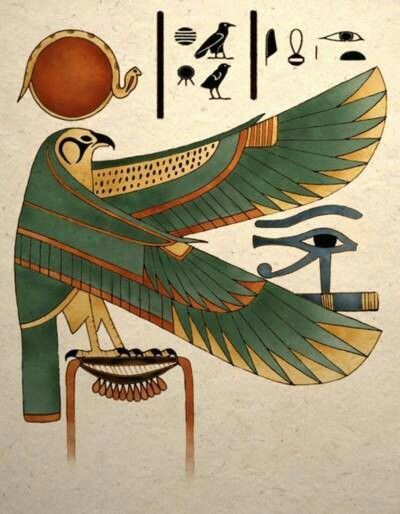
Ra shared many of his symbols with other solar deities, in particular Horus, usually depicted as a falcon. After the deities were paired with pharaohs, the children of Hathor were considered to be fathered by Ra.
- The Tree of Life
The Tree of Life is an important religious symbol to the Egyptians. The Tree of Life was located within Ra’s sun temple in Heliopolis and was considered sacred. The fruit that sprang from this tree was not available to humans, but only in aging-rituals reserved for pharaohs. The Tree of Life is also referred to as the mythical, sacred Ished tree. Eternal life came to those who ate the fruit from the Tree of Life.
- Bennu Bird or Phoenix
Another important ancient Egyptian symbol connected to Ra is the “Bennu.” The Bennu bird is Ra’s ba and a symbol of fire and rebirth. Bennu is the name of the bird that represented Ra’s soul.
This bird is a phoenix and it was seated at the Tree of Life in Ra’s Sun Temple in Heliopolis. Inside the temple, on top of an obelisk, sat the Benben Stone. This pyramid-shaped stone served as a beacon to Bennu and is also an important ancient Egyptian religious symbol. Sometimes, Ra is depicted as a phoenix, showing the connection between the two.
- Primordial Serpent and Sun Boat
Ra was thought to travel in a sun boat to protect its fires from the primordial waters of the underworld it passed through during the night.
The ancient Egyptians believed that as the sun god, Ra’s role was to sail across the heavens during the day in his boat called the “Barque of Millions of Years.” In the morning when Ra emerged from the east, his boat was named, “Madjet” which meant “becoming strong.” By the end of the day the boat was called, “Semektet” which meant “becoming weak.” At the end of the day, it was believed that Ra died (swallowed by Nut) and sailed on to the underworld, leaving the moon in his place to light up the world.
The ancient texts describe how Ra would go down with the setting sun into the underworld and then rise again the next day on the opposite side. This also symbolizes the same journey that the deceased would take right after burial.
The journey was divided into 12 hours, with each hour representing an obstacle that Ra had to complete in order to move onto the next. Each area has gods and monsters that Ra meets along the way.
Throughout his journeys and adventures, the serpent-god Apep is his greatest enemy. Apep would hide below the horizon waiting to attack Ra, and they would fight many battles. Many gods and goddesses were involved in defending Ra, including the god Seth.
Ra was reborn at dawn the very next day. Ra traveled in the sun boat with various other deities including Set and Mehen who defended against the monsters of the underworld, and Ma’at who guided the boat’s course. The monsters included Apep, an enormous serpent, or also, The Lord of Chaos, who tried to stop the sun boat’s journey every night by consuming it. In some stories, Ra, in the form of a cat named Mau, defeats the evil serpent, Apep. This is part of the reason why cats are so highly-revered in Egypt.
The Ra myth saw the sunrise as the rebirth of the sun by the goddess Nut and the sky, thus attributing the concept of rebirth and renewal to Ra and strengthening his role as a creator god.
In the Pyramid Text, Re is perpetually resurrected in the mornings in the form of a scarab beetle, Khepri, which means the Emerging One. He rides on the primordial waters, called Nun, in his sacred bark (boat) along with a number of other deities across the sky. At noon he is the falcon-headed man Harakhty, and at sunset the elder Atum, the “All Lord.” He is then swallowed by the goddess Nut, who gives birth to him each morning again as Khepri.
Therefore, the cycle continued with birth, life and death. This constant aging was suggested by some later Egyptians as the reason Ra stayed separate from the world and let Osiris or Horus rule in his place.
Often coupled with this idea is the myth in which Isis is able to trick an elderly Ra, having ruled on earth as a human pharaoh, into revealing his secret name, and thus the secret of his power. Ra subsequently lost his power, resulting in the cult of Isis and Osiris to rise in importance.
- Other Symbols
The Obelisk represents the rays of the sun and was worshiped as a home of a solar god. Other symbols include Pyramids aligned east to west, the Bull, Serpent, Heron, Lion, Cat, Ram, Hawk, Beetle, and others. His main symbol, however, is the sun disk.
Ra’s Appearance
Ra is usually shown in his human form with a falcon head crowned with a sun disc. The famous sun disc was surrounded by a sacred cobra named Uraeus. In some artistic representations of the god, he is shown as “a man with the head of a beetle” or sometimes as “a man with the head of a ram”.
Sometimes Ra is shown in animal form; most commonly, Ra is shown as a hawk, but sometimes also a beetle, lion, ram, or snake, as all of these were considered powerful animals in ancient Egypt. In iconography, Egyptians sometimes painted Ra as simply a large solar disk between two large falcon wings. Ra was incorporated into many aspects of Egyptian art, and he can be seen in paintings, sculptures, statues, and even jewelry.
Composites
As with most widely worshiped Egyptian deities, Ra’s identity was often confused with others as different regional religions were merged in an attempt to unite the country.
- Amun Re
Amun was a member of the Ogdoad, representing creation energies with Amaunet, a very early patron of Thebes. He was believed to create via breath, and thus was identified with the wind rather than the sun. As the cults of Amun and Ra became increasingly popular in Upper and Lower Egypt respectively they were combined to create Amun-Ra, a solar creator god. The name Amun-Ra is reconstructed).
It is hard to distinguish exactly when this combination happened, but references to Amun-Ra appeared in pyramid texts as early as the fifth dynasty. The most common belief is that Amun-Ra was invented as a new state deity by the (Theban) rulers of the New Kingdom to unite worshipers of Amun with the older cult of Ra around the eighteenth dynasty.
- Atum-Ra
Atum-Ra (or Ra-Atum) was another composite deity formed from two completely separate deities, however Ra shared more similarities with Atum than with Amun. Atum was more closely linked with the sun, and was also a creator god of the Ennead. Both Ra and Atum were regarded as the father of the deities and pharaohs, and were widely worshiped. In older myths, Atum was the creator of Tefnut and Shu, and he was born from ocean Nun.
- Ra-Horakhty
In later Egyptian mythology, Ra-Horakhty was more of a title or manifestation than a composite deity. It translates as “Ra (who is) Horus of the Horizons”. It was intended to link Horakhty (as a sunrise-oriented aspect of Horus) to Ra. It has been suggested that Ra-Horakhty simply refers to the sun’s journey from horizon to horizon as Ra, or that it means to show Ra as a symbolic deity of hope and rebirth.
- Khepri and Khnum
Khepri was a scarab beetle who rolled up the sun in the mornings, and was sometimes seen as the morning manifestation of Ra. Similarly, the ram-headed god Khnum was also seen as the evening manifestation of Ra. The idea of different deities (or different aspects of Ra) ruling over different times of the day was fairly common, but variable.
With Khepri and Khnum taking precedence over sunrise and sunset, Ra often was the representation of midday when the sun reached its peak at noon. Sometimes different aspects of Horus were used instead of Ra’s aspects. In Thelema’s Liber Resh vel Helios, Ra represents the rising sun, with Hathor as the midday sun and Tum as the setting sun.
- Ptah
Ra rarely was combined with Ptah; the sun “crosses” over Ptah in the underworld before Ptah is reborn, thus there would be no sun-ray when this happens. Other combinations can and do exist: The rising sun with sun ray, the noon sun with sun ray, and sitting sun with sunray. But as per the Memphite creation myth he was often said to be Ptah’s first creation, through his divine will, especially when associated with Atum or Amun.
The Legend of Ra Isis and The Snake
Although Ra was highly revered and devoutly worshiped by the ancient Egyptians, there is a story to suggest he eventually grew weak. In the Legend of Ra, Isis and the Snake, the goddess Isis knew that Ra had a secret name. This secret name possessed immense power and would allow her to perform magic spells whenever she desired to.
She knew that Ra wouldn’t willingly tell her the name so she quickly got to work. Ra had begun to age and sometimes saliva dribbled from his mouth. Isis visited with him one day. She collected the spit that dribbled down his chin and mixed it with dirt and clay. She shaped her mixture into a poisonous snake.
She set the snake in Ra’s path, and when Ra was out for a walk, the snake bit him and he immediately felt the poison rushing through his body. He was in tremendous pain and asked the other gods to help him. Isis promised to help Ra but only if he would tell her his secret name. He was resistant at first, but eventually, because of the pain he was in, Ra allowed Isis to “search through him” and in so doing, she healed him and Ra’s power was transferred over to her.
The Birth of Humans
One myth tells us that Ra first came to power during the golden age. Everything was perfect and just as it should be. The earth had not been tainted in any way. The sight of such perfection moved Ra to tears and they fell to the earth. The tears grew into humans.
At first, Ra was infatuated with watching humans interact and grow. But then he became angered with them as they ended the golden age that he had loved so much. They were cruel to each other and were ruining the earth.
He summoned the goddess Hathor and transformed her into a savage lioness. He then sent her to earth to kill every human. Hathor attacked every human she came across, killing most. But before she could eliminate all humans, Ra had a change of heart. He decided he needed to stop Hathor and did so by giving her enough beer to intoxicate her. She forgot her mission but the damage she had caused was permanent. Humans had been introduced to death and now all faced their immortality.
Quick Facts About Ra
- The ancient Egyptians worshiped Ra to such an extent above other gods that some historians have argued that ancient Egyptian religion was indeed a monotheistic one with Ra as the singular god.
- Historians believe that the pyramids might represent rays of sunlight, further connecting the pharaohs with Ra, the sun god.
- During Ra’s journey through the heavens he was accompanied by several other gods including Thoth, Horus, Hathor, Maat, Abtu, and Anet.
- Nut, goddess of the sky and heavens, is sometimes referred to as Ra’s mother, because he emerges from her and is reborn every morning.
- The morning manifestation of Ra is known as “Khepri the scarab God.”
- The evening manifestation of Ra is known as the ram-headed god, Khnum.
- The sacred cobra that encircled Ra’s crown symbolized royalty, sovereignty and divine authority.
- The right eye of Ra represented the Sun; while the left eye of Ra represented the moon.
- Ra is also closely associated with the Tree of Life myth, the Ben-Ben Stone and the Bennu Bird myths.
- Ra’s glory came to an end during the time when the Roman’s conquered Egypt in 30BC.
The Creation of Ra
Ra did not have parents. He is considered to be self-created and there are many myths that suggest how this came to be. It is said that before there was any land or recognizable landscapes, there was a body of water called Nun. The water was powerful and a shining egg arose from the darkness. Inside this egg was Ra. Sun rays landed on his body and gave him the power of sunlight. He then created all other elements of life by speaking their secret names. He spent his days traveling across the sky on a boat, where he carried prayers and blessings for the living.
At night, he would travel to the Underworld where Set and Mehen would help him defeat demons and monsters. He would leave the moon in the sky while traveling to the Underworld so that the living would still have light. It is said that he was reborn each day as the sun would rise over the horizon.
The Family of Ra
Ra had several siblings, including Apep, Thoth, Sobek and Serket.
Early in his myths Ra was said to be married to Hathor and they were the parents of Horus. Later his myths changed Hathor into Ra’s daughter. This featured prominently in the myth often called The Story of Sekhmet, in which Ra sent Hathor down to punish humanity as Sekhmet.
The Middle Kingdom saw Ra being increasingly combined and affiliated with other deities, especially Amun and Osiris.
Together with Atum, Ra was believed to have fathered Shu and Tefnut who in turn bore Geb and Nut. These in turn were the parents of Osiris, Isis, Set (also known as Seth), and Nephthys. All nine made up the Heliopolitan Ennead.
Worship of the Sun God
The New Kingdom brought new heights of worship to Ra. Many tombs in the Valley of the Kings portray depictions of Ra and his journey through the underworld. During this time, many solar temples were built.
Solar temples were built for Ra but did not contain a statue of the god. Instead, they were created to be open to the sunlight that Ra represented. The earliest known temple built in honor of Ra exists in Heliopolis meaning “City of the Sun” (now a Cairo suburb). This solar temple is known as “Benu-Phoenix” and is believed to have been erected in the exact spot where Ra emerged into creation.
In later Egyptian dynastic times, Ra was merged with the god Horus, as Re-Horakhty (and many variant spellings). When his worship reached this position of importance in the Egyptian pantheon, he was believed to command the sky, the earth, and the underworld.
His local cult began to grow from roughly the second dynasty, establishing Ra as a sun deity. By the fourth dynasty the pharaohs were seen to be Ra’s manifestations on earth. Fifth Dynasty and subsequent pharaohs were all known as “The son of Ra” and Ra became incorporated into every pharaoh’s name from then onward. His worship increased massively in the fifth dynasty, when he became a state deity and pharaohs had specially aligned pyramids, obelisks, and solar temples built in his honor.
During the Middle Kingdom, the new deity, Amun-Ra was formed. Amun was one of the gods who formed the Ogdoad (the assembly of eight gods who represented eight elements of creation).
It appears almost certain, that the Great Ennead – the nine deities of Atum, Geb, Isis, Nut, Osiris, Nephthys, Seth, Shu, and Tefnut – first appeared during the decline of Ra’s cult in the sixth dynasty, and that after introduction of the new pesedjet the cult of Ra soon saw a great resurgence until the worship of Horus gained prominence.
As the king and leader of Egypt, the pharaoh was seen as the human manifestation of Horus, so the two gods became connected. This new deity fusion was then referred to as “Ra-Horakhty” meaning Ra is Horus of the Horizon. Ra’s relationship with other gods did not stop there. As the powerful creator of mankind and the sun god, he also became associated with Atum to make “Atum-Ra.”
Afterward worship focused on the syncretistic solar deity Ra-harakhty (Ra, who is Horus of the Two Horizons). During the Amarna Period of the eighteenth dynasty, Akhenaten introduced worship of another solar deity Aten. The deified solar disc represented his preferred regional deity as he attempted to lessen the influence of the temple of Atum. He built the Wetjes Aten (Elevating the Sun-disca) temple in Annu. Blocks from this temple later were used to build walls to the medieval city of Cairo and are included in some of the city gates. The cult of the Mnevis bull, an embodiment of Ra, had its centre here and established a formal burial ground for the sacrificed bulls north of the city.
In the later myths Ra was seen to have created Sekhmet, the early lioness war goddess who becomes Hathor, the cow goddess after she has sufficiently punished mankind as an avenging Eye of Ra.
This changes the themes of much earlier myths into aspects of his and he is often said to be the father of both, and brother, to the god Osiris. Afterward nearly all forms of life supposedly were created only by Ra, who called each of them into existence by speaking their secret names and eventually humans were created from Ra’s tears and sweat, hence the Egyptians call themselves the “Cattle of Ra.”
Although not the contemporary view, E. A. Wallis Budge (1857-1934) claims that Ra was the one god of Egyptian monotheism, of which all other deities were aspects, manifestations, phases, or forms.
During the New Kingdom, the worship of Ra became more complicated and grand. The walls of tombs were dedicated to extremely detailed texts that told of Ra’s journey through the underworld. Ra was said to carry the prayers and blessings of the living with the souls of the dead on the sun boat.
The idea that Ra aged with the sun became more popular with the rise of The New Kingdom. Eventually, during the reign of Akhenaten (mid 1350s-1330s), the worship reached the level of “uncompromising monotheism”
Many acts of worship included hymns, prayers, and spells to help Ra and the sun boat overcome Apep. Though worship of Ra was widespread, his cult center was in Heliopolis in Lower Egypt. Oddly enough, this was the home of the Ennead that was believed to be headed by Atum, with whom he was merged. The Holiday of ‘The Receiving of Ra’ was celebrated on May 26 in the Gregorian calendar.
Though Ra lived on in various forms into the Greco-Roman period, his worship gradually deteriorated during the fist millennium. This decline was probably due to the weakening of the kingship under various foreign rulers. Though he continued to be a part of Egyptian theology, he was no longer a part of the peoples living faith. Devotion to Ra became more and more limited to priests of the temple.
The rise of Christianity in the Roman empire caused an end to worship of Ra by the citizens of Egypt, and as Ra’s the popularity suddenly died out, the study of Ra became purely for academic knowledge even among the Egyptian priests.
Sources:
Many spells, especially those that request healing or protection for animals, or those to locate lost animals, suggest consecrating the animal to a spirit. Although there are also many others, the following have earned a reputation as renowned animal protectors. Incorporate them into your spells as needed:
- Spirits that protect cats: Artemis, Bastet, Freya, Hecate, Lilith
- Spirits that protect big cats (tigers, lions, leopards, etc): Dionysus, Durga, Hathor, Kybele, Sekhmet
- Spirits that protect dogs: Artemis, Hecate, Ogun, Saint Roch
- Spirits that protect horses: Anat, Demeter, Epona Poseidon, Rhiannon, Rla-mgrin (Hayagriva)
- Spirits that protect toads: Agwe, Heket
- Spirits that protect snakes: Athena, Ezili, Freda, Dahomey, Lilith, Mami Waters, Simbi, Lady Asherah
- Spirits that protect cows: Brigid, Hathor, Hermes, Isis, Lakshmi, Maeve, Shiva
- Spirits that protect fish: Atargatis, La Baleine, La Sirene, Yemaya
- Spirits that protect pigs: Demeter, Seth
- Spirits that protect animals in general: Aphrodite, Artemis, Baba Yaga, Faunus, Hathor, Lilith, Saint Anthony
Note: Saint Anthony is the spiritual detective – request his assistance when a pet is missing.
Found in:
Element Encyclopedia of 5000 Spells
- Also known as: Morrigu, Morrigna
- Origin: Ireland
- Birds: Corvids: Crow, Raven, Roo
- Creatures: The Morrigan owns a herd of enchanted magickal cattle
- Color: Red
- Day: Samhain
The Morrigan is a Celtic goddess of battle, strife, and fertility. Her name translates as either “Great Queen” or “Phantom Queen,” and both epithets are entirely appropriate for her. The Morrigan appears as both a single goddess and a trio of goddesses.
The Morrigan is a powerful spirit of birth, death, sex, destruction, and fertility. She is among the goddesses associated with Ireland’s well-being and sovereignty. Her name is variously translated as:
- Great Queen
- Sea Queen
- Phantom Queen
- Terrifying Queen
She is an oracular, prophetic spirit who can reveal the future and anyone’s destiny – that is, if she feels like it. The Morrigan is a headstrong, passionate goddess who does as she pleases. She is among those goddesses serving as Washers at the Ford
The Morrigan may be one spirit, a triple goddess, or three manifestations in one. The Morrigan may name a triad of distinct goddesses – usually Badbh, Nemain, and Morrigan, but sometimes Macha is included.
The Morrigan is most famous as a war goddess. She may instigate battle or meddle with it. The concept of minding her own business does not exist: Battle is her business. Anything that captures her interest is her business. The Morrigan is also renowned for giving sound battle advice. She advised the Dagda on how to deal with the fumorians.
The Morrigan determines war’s outcome, bestowing victory to whichever army or warrior she favors, but she has a reputation for being capricious. Her favors can never be taken for granted. Her frenzied war fury unnerves armies. Her shriek is deadly.
The Morrigan frequently appears in the ornithological guise of a hooded crow. She is one of the Tuatha Dé Danann (“Tribe of the goddess Danu” or the land of the Faries) and she helped defeat the Firbolg at the First Battle of Mag Tuireadh and the Fomorians at the Second Battle of Mag Tuireadh. She is often read about in books that are about the Fae.
Her many manifestations include, but are not limited to:
- A beautiful woman
- A hag.
- A crow
- A deer (doe or stag)
- A white heifer with red ears and no horns
- A black eel long enough to coil three times around the legs of Cu Chulain, a great man.
She appeared to the hero Cu Chulainn (son of the god Lugh) and offered her love to him. When he failed to recognize her and rejected her, she told him that she would hinder him when he was in battle. When Cu Chulainn was eventually killed, she settled on his shoulder in the form of a crow. Cu’s misfortune was that he never recognized the feminine power of sovereignty that she offered to him.
She appeared to him on at least four occasions and each time he failed to recognize her.
- When she appeared to him and declared her love for him.
- After he had wounded her, she appeared to him as an old hag and he offered his blessings to her, which caused her to be healed.
- On his way to his final battle, he saw the Washer at the Ford, who declared that she was washing the clothes and arms of Cu Chulainn, who would soon be dead.
- When he was forced by three hags (the Morrigan in her triple aspect) to break a taboo of eating dog flesh.
More than just a battle goddess, the Morigan is also a goddess of life, birth, and sex. She is sometimes identified as a mermaid. On Samhain, the beginning of the Celtic dark half of the year, the Morrigan stands astride a river with one foot on either bank to engage in the Great Rite – sacred, transformative, ritual sex – with the Dagda (Ireland’s All-Father).
Sources:
- Redbubble
- The Encyclopedia of Spirits
- Also known as: Mene (as in month or menstruation), and Latin Luna
- Origin: Greece
- Stones: Moonstones and Selenite (literally “moon rock”)
- Favored people: She is the matron of magicians, sorcerers, witches, and moon-gazers.
Selene is an ancient goddess of the moon. Comparatively little information regarding Selene’s veneration and rituals survives although she is described as “great in magic” and was apparently invoked in magic spells. Her parents are Titans, Hyperion and Theia. Helios, the sun, is her brother. Many of her functions were later transferred to Artemis as Helios’ were to Apollo.
Selene bathes in the ocean before riding up to the sky in her chariot every night, variously driven by a pair of white horses, bulls, or mules. She pulls the full moon across the sky. Alternatively she rides a horse sidesaddle. Sometimes Selene has to hide from a dragon, indicated by a lunar eclipse or absent moon. Or perhaps Selene is just making time with that dragon. Selene is an amorous goddess with many lovers including Pan and Zeus, with whom she had numerous children.
Her most famous love affair is with the young shepherd Endymion, the male sleeping beauty. Selene placed him under an eternal sleep spell so that his entire existence consisted of sleeping and making love to her. Selene spends her days in the Anatolian cave in which Endymion sleeps.
Selene’s name is etymologically related to a word meaning “light.” In her guise as the full moon, Selene sheds light on problems and mysteries.
- Manifestation:
Selene is the goddess of the moon, but she also is the moon. Selene may manifest as a woman or a cow, but you can also gaze at the moon and see her. As a woman, she is described as being very beautiful. She has wings and wears a diadem.
A scholarly article about the Goddess Selene:
Also called Mene, or Latin Luna, Selene was the goddess of the moon, or the moon personified into a divine being. She is called a daughter of Hyperion and Theia, and accordingly a sister of Helios and Eos; but others speak of her as a daughter of Hyperion by Euryphaessa, or of Pallas, or of Zeus and Latona, or lastly of Helios. She is also called Phoebe, as the sister of Phoebus, the god of the sun.
By Endymion, whom she loved, and whom she sent to sleep in order to kiss him, she became the mother of fifty daughters; by Zeus she became the mother of Pandeia, Ersa, and Nemea . Pan also is said to have had connection with her in the shape of a white ram.
Selene is described as a very beautiful goddess, with long wings and a golden diadem, and Aeschylus calls her the eye of night. She rode, like her brother Helios, across the heavens in a chariot drawn by two white horses, cows, or mules. She was represented on the pedestal of the throne of Zeus at Olympia, riding on a horse or a mule; and at Elis there was a statue of her with two horns.
In later times Selene was identified with Artemis, and the worship of the two became amalgamated. In works of art, however, the two divinities are usually distinguished; the face of Selene being more full and round, her figure less tall, and always clothed in a long robe; her veil forms an arch above her head, and above it there is the crescent. At Rome Luna had a temple on the Aventine.
Ritual to Selene
- Color: White and silver
- Element: Water
Altar: Lay with a white cloth, on which is sewn moons of silver in cycle from new to dark. Set out two white candles rubbed with jasmine oil, a silver tray with round white cakes, a glass pitcher of goat’s milk, a glass chalice of white wine, a glass of clear anise liqueur, a round mirror, and a silver bell.
Offerings: White foods. Milk, poured in libation. A promise to aid those suffering from mental illness or emotional confusion.
Daily Meal: Nothing but milk or rice milk to drink. Rice. Custard. Cream soups and sauces.
Invocation to Selene
Lady of the Full Moon
White Lady whose rays shine on us
Lighting our path through the darkness
Round as a full belly
Pregnant with possibilities,
White as mother’s milk
And snow on high mountaintops,
Moon mother who sings to us
Lullabies of imagination,
Cascade through our dreams,
Sail us through the ebb and flow
Of our heart’s tides,
And light our spirits
With your serene love.
Chant: Luna Lucina Lumen Lumen
The cakes are passed around, saying, “Eat of the Mother’s sweetness.” Then the pitcher of milk is passed around, saying, “Drink of the Mother’s love.” Then the chalice of wine is passed around, saying, “Drink of the Mother’s dreams.” Then the glass of liqueur is passed around, saying, “Drink of the Mother’s song.” Then the remainder are poured out as libations and the silver bell is rung six times.
Sources:
